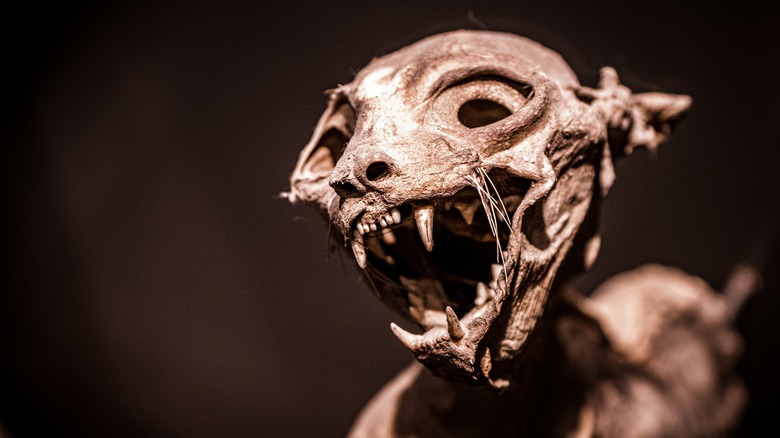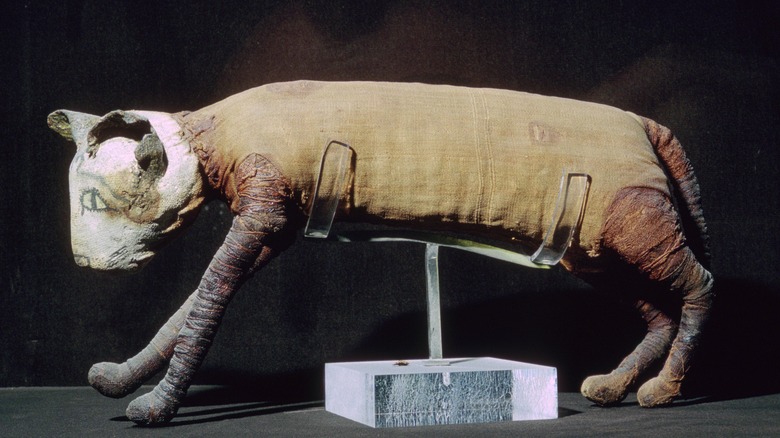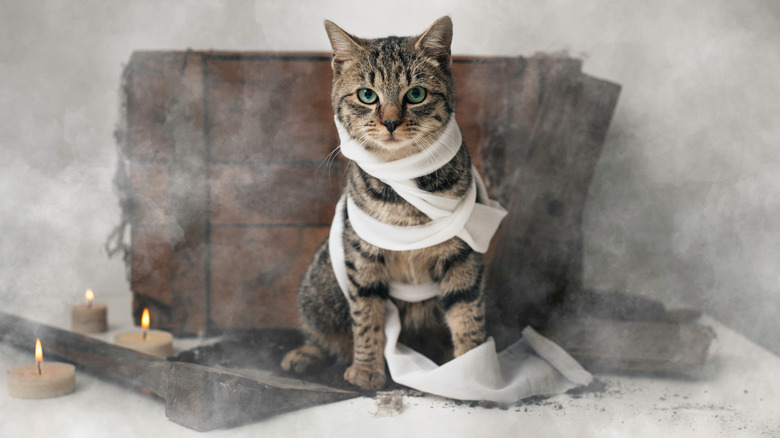The Strange Reason Mummified Cats Are Found Inside The Walls Of Old Homes
"Hey honey, I heard a strange noise outside — I think the witch is back. Can you grab the cat? No, the dead one. We've got a spot here in the kitchen. I already cut a hole out just in case. Oh of course, it was no problem at all! Yep. Now, just ... this paw up, this paw down. Nice attack pose, see? Okay, in the wall you go! Take that, witch! So are you thinking stew for dinner, or stew?"
Um ... what?? While a household scene from antiquity might not have played out exactly like that little vignette, there's more truth in there than you might realize. Were folks of European yore concerned that spirits, ghosties, beasties, goblins, etc., might seize upon them in the night? Sure. Folks today across the world are still besieged by 10,000 superstitions. However, the practice of stuffing dead cats into walls has thankfully fallen by the wayside — we assume. Just don't go taking sledgehammers to people's homes to find evidence that they've been using the corpse of Garfield to ward off the evil eye.
As sites like Curiosities from the 5th Corner describe, some people indeed used to deposit dead cats in their walls to protect against bad mojo. Cats, after all, have held a long and strange association with the supernatural across multiple cultures. "Dried" cats, mummified over time, have been found in walls from medieval times to the 20th century.
The mystical, magical feline
Any discussion of mummy cats would be remiss to leave out the OGs of mummification: ancient Egyptians. While we're not sure if cats in ancient Egypt stared off inexplicably at nothing before sprinting into zoomies across the floor and instantly collapsing into a side-laying position ... Okay, you know what? Of course cats were doing that. And so that special bond was formed, the one where humans are certain that cats are mystical, magical creatures capable of penetrating realms unseen and untraversable except to those of feline majesty. That must be why the cat is two inches away from the wall and facing it for no reason. It's ghosts, you see.
Within such comedy lives truth, much like earlier in this article. Yes, as the Carnegie Museum of Natural History describes, cats were a sacred animal in Egypt – folks even used to mummify them to take them along to the afterlife (pictured above). We know that Egyptian religious practices influenced the ancient world a lot, particularly Greece, and then Greece influenced Rome, and then the Romans marched their armies off across Europe all the way to Briton.
Fast-forward 2,000 years and we find a walled-up, mummified cat dating to the 17th century in a place like Lancashire, England, per CNN. Pre-Christian, heathen practices lived on through 15th-to-18th-century witch hunts that also targeted cats believed to be "familiars," as The Collector explains. But to the common person, cats weren't sources of magical evil, but magical protection.
One foundation sacrifice amongst many
To be fair, exact causality across time and culture regarding the mystical, protective powers of cats is impossible to know. In fact, the "my dead, dried cat is a protective device against witches and devils" hypothesis is just our best guess. After all, folks weren't exactly writing this stuff down; they were too busy stuffing remains into walls.
Relatedly, Lapham's Quarterly says that foundation sacrifices were not uncommon when witch hunts were at their height. Loads of objects besides cats were embedded into foundations to appease the powers that be, including "witch bottles" filled with urine, hair, and nails near thresholds and hearths, shoes, horse skulls, and more. In some cases, these items were designed as "decoys" to keep dumb spirits off the trail of the living. And yes, the word "sacrifice" — horrifyingly so — implies that some cats might not have been exactly dead when interred in walls. If the wailing helped ward away spirits, it definitely didn't help the living sleep.
The aforementioned mummy cat in Lancashire, England is just one example of several. In 2009 the BBC described a similar finding in Ugborough, where a local legend pointed to the existence of such a cat. Some builders came across one in a house, after which the owner, Richard Parson, said, "My first thoughts were that we didn't need it in the house but actually it adds a bit of colour to the village so we're going to put it back."


